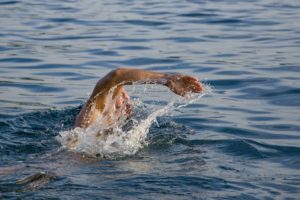Swimming is highly technical. Swimming doesn’t require great strength, it requires great technique. If you make mistakes, those mistakes compound upon themselves and suddenly, swimming is a tremendous challenge.
 Swimming was my first athletic language. I started when I was eleven and swam competitively through college. I hung up my competitive Speedo shortly after the U.S. Olympic fiasco in 1980 and began eyeing this crazy new sport called Triathlon. In 1982, after Julie Moss made her epic crawl across the finish line, participation in the sport exploded. For 36-years, I’ve watched as athletes have repeated the same swimming mistakes.
Swimming was my first athletic language. I started when I was eleven and swam competitively through college. I hung up my competitive Speedo shortly after the U.S. Olympic fiasco in 1980 and began eyeing this crazy new sport called Triathlon. In 1982, after Julie Moss made her epic crawl across the finish line, participation in the sport exploded. For 36-years, I’ve watched as athletes have repeated the same swimming mistakes.
You can improve your swimming by avoiding those same mistakes. In no particular order, the biggest mistakes I see age-group triathletes make surrounding their swimming –
Discounting the Importance of the Swim – There is rarely a week goes by I don’t hear a triathlete say, “The swim is only 15% of my race so I’m only going to spend 15% of my training time swimming.” The fallacy of that argument becomes clear when you consider the swim impacts the swim/bike/run. The bike impacts the bike/run, while the run impacts only the run. It’s true you can’t win a triathlon in the water; however, you can sabotage your entire day there. The goal of a triathlon swim is to remain aerobic in the water. Unless you have “meters-in-the-bank” from a competitive swimming career, you aren’t going to be able to remain aerobic in the water devoting only 10-15% of your training time to swimming. I encourage the athlete’s I work with to build their typical main set to 1.5-2.0 times the race distance, a minimum of three times per week. If you’re training for an Olympic triathlon, that would work out to 2,250-3,000 meters, three times a week.
Trying to “Do it Yourself” – There is simply no replacement for eyes on deck as you learn to swim properly. Yes, there are countless resources available on-line – YouTube videos, self-help books, expertly crafted instructional packages – none of those will replace eyes on deck in the form of a qualified coach/instructor. I’m sure right about now there is someone thinking, “Well, I completed “XYZ” swim training and now I can do triathlons just fine.” I submit that getting across the pool isn’t the same as swimming. The biggest problem with teaching yourself to swim is that you don’t know if you’re “doing it right.” When I video-tape an athlete and then review the video with them, universally I hear, “I had no idea I was doing that.” Remote video analysis can be helpful; however, it takes multiple sessions to make meaningful progress. One of the best things you can do for your swimming is to schedule a couple of one-hour lessons with a qualified coach/instructor.
Over-Reliance on Drills – I regularly see the question here in the forums – “What drills can I do to improve my swimming?” Shortly after that question appears, there will often be multiple responses recommending various drills to “fix their swimming.” The problem is nobody has seen anybody in the water. That makes all the suggestions to fix their swimming a wild guess. Unless a qualified coach/instructor has prescribed a drill to correct a specific and identifiable stroke deficiency, you are better off swimming. Once you have been prescribed a drill, you should see near immediate results and likely not need to do the drill more than a couple of weeks. Spending a quarter to half of your valuable workout time doing pointless drills will quash your swimming as fast as not working out at all. If you want to become a better swimmer, then you need to swim.
Ignoring the Fundamentals – When children learn to swim, they start with simple things – putting their face in the water with no goggles, blowing bubbles; blowing bubbles from their nose; learning to float. For the kids, that’s fun. When I ask an adult to do those same things, I often hear, “I’m not doing those childish things.” Ironically, it’s often those same adults that struggle in the water. Do you have a problem with your balance in the water as your legs drop creating drag? Learning to float teaches you to control your extremities. Do you find yourself struggling to get enough air when you breathe? Learning to blow bubbles goes directly towards this problem. Whenever I hear someone ask about a nose clip or see an athlete grab their nose as they enter the water, I think, “They didn’t learn the fundamentals.” Will learning the fundamentals suddenly make you a faster swimmer? Maybe not, but it will help you overcome basic problems that stem from not having a solid fundamental foundation.
Long Continuous Swims – How you use your time in the water is critical to your progress. Swimming is highly technical and reliant upon good stroke technique. One of the goals of any workout should be to store proper technique to muscle memory. Doing long continuous swims in training introduces fatigue. As you fatigue, your stroke technique degrades – resulting in poor technique being stored to muscle memory. A better approach is to do intervals – i.e. 15 x 100 w/20 seconds rest. Doing that set gives you the benefit of a 1,500-meter main set, and it also gives you the added benefit of good technique during the entire workout.
Dislike Swimming – Is swimming a necessary evil, or do you truly look forward to getting in the water? If you despise swimming, that negative attitude will hold you back from reaching your full potential in the water. I get it, if you struggle with swimming, it can be difficult to look forward to more struggles. If what you are doing isn’t working – change it. Hire a coach, hire a different coach, change your workout routine. Anything you can do to turn your struggles in the water into success in the water will help you learn to love swimming.
Insufficient Volume – I touched on this a little bit earlier but it’s important enough to re-visit. I’ve been asked, “What’s the minimum swim volume I can do to be prepared for my race?” I invariably turn that question around and ask, “What’s the maximum volume you can achieve?” 1:30/100y is a relatively easy benchmark to reach. 1:30/100 will yield a 1:03 Ironman swim. 6,300 yards three times per week will get most triathletes to that pace. That’s roughly two-hours, three times a week. Before you say that’s too much time in the pool, consider that a typical training ratio is – Swim 25%: Bike 50%: Run 25%. If your maximum volume during an Ironman build is 20-hours per week, swimming six of those hours puts you nicely in the typical volume ratio. Instead of trying to minimize your time in the water, don’t be afraid to increase your volume. Your swimming will thank you for it.
By no means is this a comprehensive list of the mistakes I have seen athletes make in the water – it’s just the most common mistakes I see. I didn’t talk about the details of swimming – i.e. proper hand entry, how to initiate the catch, etc. If you eliminate the mistakes I outlined about, all the details will largely take care of themselves.
Swimming doesn’t have to be hard. Eliminating the most common mistakes will have you on a path to faster swimming. Who knows, you might even grow to love swimming!
